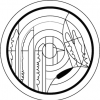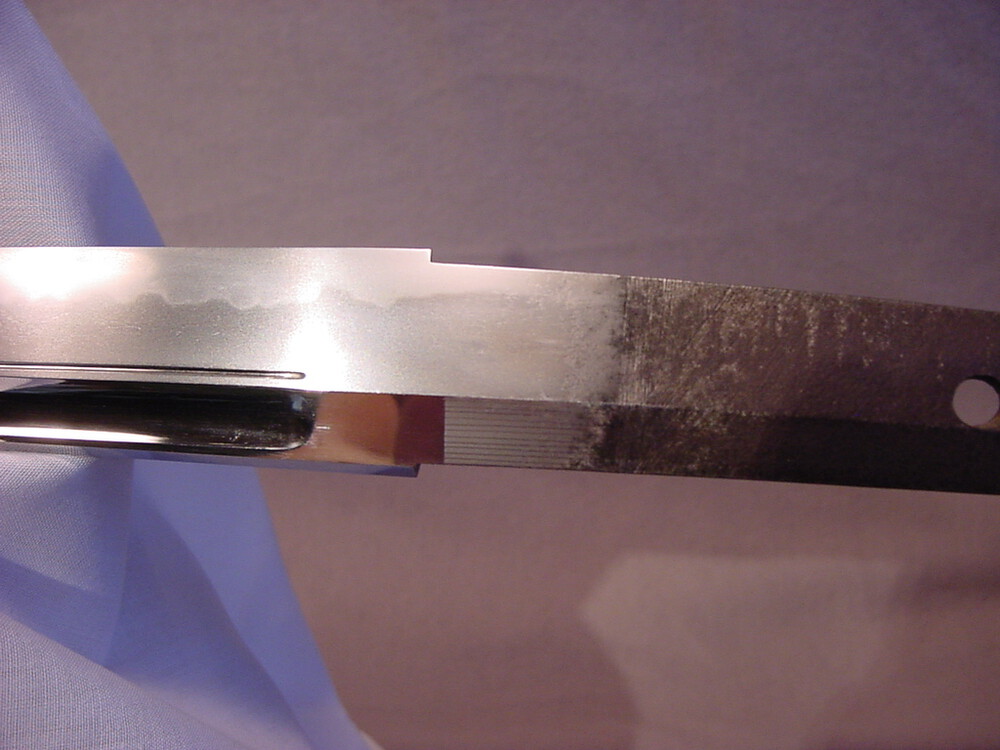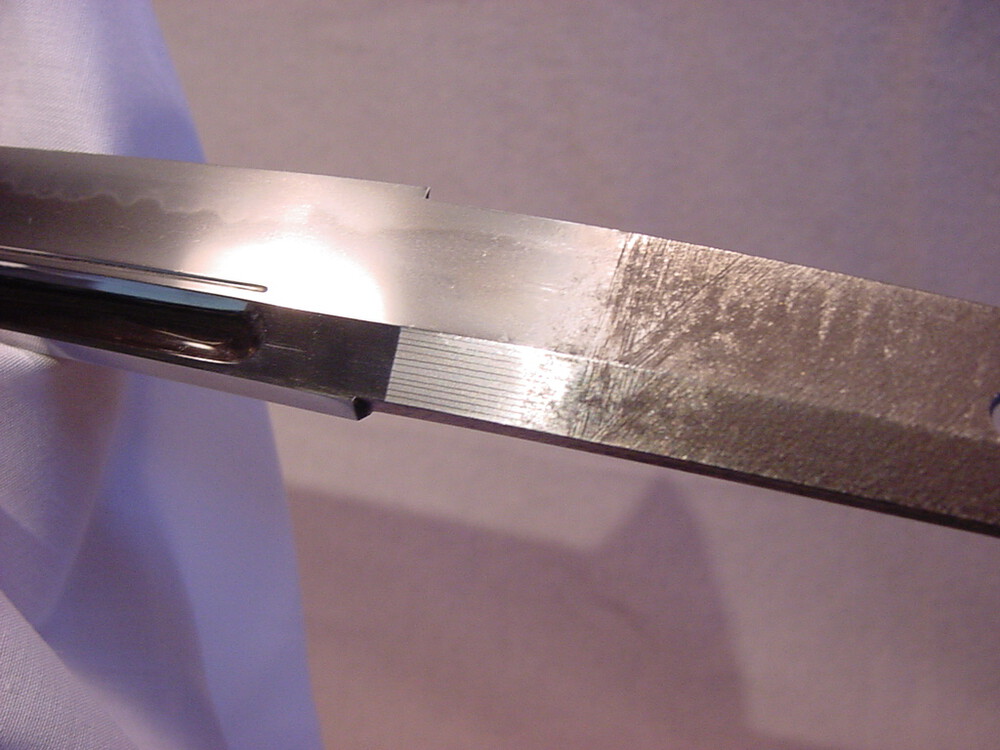-
Posts
995 -
Joined
-
Last visited
-
Days Won
12
Content Type
Profiles
Forums
Events
Store
Downloads
Gallery
Everything posted by Ted Tenold
-
I'd add that while finding such pieces in old catalogs is good for lighting a warm nostalgic glow, they rarely lend credible authenticity to the piece as an original work unless authoritative and reliable provinance accompanied them prior to their illustration. Old books are filled with questionable pieces and most times tell us more about their travels than what they truely are.
-
The Nobukuni smiths of Chikuzen province in Shinto and Shinshinto periods signed this way with Yoshi as a common first character, but there's nothing on a Yoshihiro in their lineages. That said, the nakago looks altered and the mei suspiciously new and out of context for the character of that school's style so I'd doubt it's an undocumented smith. I think any merits the blade may contain as a restorable piece will depend in it's work which isn't visible in the images. The shape looks older than Shinto to me. Maybe a late Muromachi piece that's been fussed with for whatever reason. The tsuba is signed Umetada Shichizaemon Tachibana Shigeyoshi Saku.
-

Japan Earthquake
Ted Tenold replied to nagamaki - Franco's topic in General Nihonto Related Discussion
That is good news Guido, thank goodness. I hope we continue to hear such news from everyone. This news is horrible indeed. I was shocked when opened my newspage with my first cup of coffee to see this. All our prayers and wishes for safety for everyone in Japan and those around the Pacific Rim that yet might potentially be affected by the resulting tsunami threat. A friend in Tokyo has a blog and he wrote that the damage was minimal given the magnitude of the quake. Shelters are opening up all over. Trains and subways shut down. Vending machines dispensing food and drinks for free, electronics stores offering free recharging of cell phones. Power and water are still working in Tokyo apparently. Again, my prayers and wishes for all our members, families, friends, and especially those most directly in the path. -
Chris, I remember seeing yours and noting the difference in work style. This is the one I had; http://www.legacyswords.com/fs_ant_daito2.htm It was mumei with NBTHK Hozon Kanteisho.
-
Based on what is visable in the images, it reminds me of Geishu Masamitsu work. Shinshinto maker from the Owari Motonaga school.
-

tampa show
Ted Tenold replied to lbkmd43's topic in Sword Shows, Events, Community News and Legislation Issues
Yes, I heard from Andy Quirt that it walked in. Not sure who got it actually, but it didn't take long to sell. :lol: I was occupied with something else and didn't get a look at it. -

tampa show
Ted Tenold replied to lbkmd43's topic in Sword Shows, Events, Community News and Legislation Issues
I completely concur that this was the best Tampa show I've ever attended. Uncle Al really picked up the reigns and put the spurs to this show. The energy was great, the moral was high, and the traffic was much better. Several times he announced swords that were walking in the door "for sale", and anyone could have a chance to see them and make an offer. A couple decent swords walked in and were bought. As Andy pointed out, Al busted out a fat stack for the advertising campaign with ads in several gun and antique based publications, local antique circulars, etc.. He put a *lot* of his own money on the line to do this show right and I think it'll pay off as momentum gathers. One of the things I noticed was the number of new folks coming in that were just getting started. THAT is very encouraging to a field that needs a next generation. I was very happy to see this. Big cheer for Uncle Al Bardi! I wouldn't dream of missing it next year. Thanks also to everyone who attended. It was great seeing so many friends and new faces. -
Hi Rich, my email is not dead. You may have an improper link to a very old page or something in a cache. http://www.legacyswords.com You can reach me through there, or here by PM. I do take commissions, but they're subject to acceptance. I talk myself out of more work than I talk myself into because so many swords aren't good candidates for restoration and I'd rather see folks put money into worthy candidates or those available at a comparable investment that are provide immediate gratification (in other words; done and enjoyable ). The images of your sword won't be enough for any polisher to fully say yay or nay. In hand examinations are the only way they can be evaluated. Images just get you past the *really* obvious disqualifiers. As Jean mentioned, yours could be a late koto piece. This shape was done by many different schools such as Shitahara, Mihara, Bizen and others. Entering the Shinto period this form rarely made. As noted by Grey, the shape illlustrates the blades overall mass has been greatly depleated because machis have been reinstalled by grinding down the nakago on the ha and mune edges of the habakimoto. This will make the proper fitting of a habaki impossible without further disruption of the entire nakago. So what do we have at the end of the day here? A probably Sue-Koto piece of questionable quality, likely of compromised health, that needs polish, nakago alteration, repatination, new habaki, new shirasaya. Even on the cheap you're probably looking at $2500 *without* papers, shipping, insurance, brokerage. None of which include your preliminary purchase price of the sword. For what? There are a lot of decent swords out there starting in this range that won't test your patience and tie your hard earned cash up for two years, and also without the risk. If this piece comes up with hagire, fukure, shintetsu, etc., etc., etc., then it's dead as the cash you put into it. Without attempting to appear rude, I think it has as much chance of being a Kiyomaro school piece as I have being crowned King of Norway. Even if it went to Kiyomaro or Kiyondo, it's mumei and of greatly compromised condition for a shinshinto piece, and thus no appreciable potential.
-

Kanji denoting a particular month
Ted Tenold replied to Ted Tenold's topic in Translation Assistance
Gentlemen, Thank you all very much for your help! -
Hi All, Okay, I've looked at this one and came up with Taisho Go Nen "Goki or Goku Gatsu", or "San Gatsu or Yoshi Gatsu" Juichi Jitsu. I thought perhaps that it might be "San Gatsu" as perhaps a poetic Lucky/March, but I'm doubtful. Goki or Goku is "extreme" "last" or "final" so I thought December?? Help would be appreciated and contribute to lowering my intake of Ibuprofen. :lol: Many Thanks!
-
I find it humorously ironic that a subtle mistake in the link took us from an on-line review of a video production, to a view of an on-line video producer. :lol:
-
One word: 中国 Fortunately you don't have to now. But then again...why would you want to?
-
Peter, I agree it is not overtly garrish. Clearly it was not designed for a sword blade but is hollow, probably to carry personal items such as writing supplies, money, medicine, messages, etc.. I believe this may be a Doctor's sword (Bokuto) which also were not designed to carry blades but were either mounted with a faux blade (I had one with a buffalo horn blade) or were a solid single piece that didn't open at all. I once saw a good collection of Bokuto, and the workmanship on some was very similar and very nice in hand. There's much more work in those than meets the eye. I'd challenge someone to make it's equal for $370.00.
-
Hi All, Just to be clear, I am not the seller of this sword anymore. That listing is quite old, and is still in the background on my site I guess. I pulled the listing from view at the owner's request a *long* time ago. It was subsequently offered by another dealer later down the road. In order to prevent any potential confusion with the current seller, I've asked Josh to remove the link and provided him with two images of the machis that clearly illustrate the health of the piece. This sword was shown at the NBTHK/AB lecture in San Francisco last year. It is a stunning piece in hand.
-
They all look like hardcore ABBA fans to me... well, except for that tall guy in the back. He probably digs Siouxsie and the Banshees!
-
PM sent.
-

Florida show
Ted Tenold replied to Grey Doffin's topic in Sword Shows, Events, Community News and Legislation Issues
We'll planning to exhibit examples by Gassan Sadakatsu Kasama Shigetsugu Tsukamoto Okimasa Shibata Ka Sa Nobumitsu (a rare Naginata made in 1941) Kanefusa (23rd Generation) Yasukuni Jinja smith, Kajiyama Yasunori (aka: Yasutoku) Yasukuni Jinja smith, Kajiyama Yasutoshi Minatogawa Jinja smith, Masanao -

Florida show
Ted Tenold replied to Grey Doffin's topic in Sword Shows, Events, Community News and Legislation Issues
I'll be attending as well. The NBTHK/American Branch lecture and display will be on Gendaito, and have some very nice and unusual examples. -
Listen to the wisdom of this man! I'd like to add that I do a great deal of work for practitioners and have seen some frightful maintenance issues. The "fixes" sometimes did nothing more than make it worse or more hazerdous. I recommend that a working blade in regular use (two sessions per week) have a new tsukamaki about every two years, and more often if in more frequent use or something sounds or feels wrong. The tsukamaki plays an important part in the composite construction of the handle. It's not called "binding" without reason. Also, the handle can be more fully inspected for damage and deterioration that can't be seen otherwise. Rayskin can also crack and deteriorate and not every handle is a maedarekise (fully wrapped) construction. Panels leave the shitaji (foundation) under the ito at the ha and mune to take the brunt of shock and stress of torque and impact. A well installed ito "binds" and reinforces the seams in the foundation. A noisy tsuba signals some form of settlement or migration. Where and why are the questions. How to fix depends on the answer to those two questions. It can be as simple as a cracked or worn mekugi, or as Tom pointed out, more serious issues of a habaki migrating because it (or the blade) is damaged. In the latter case, adding more seppa or leather just imparts the stress back on the habaki to migrate further. Koshirae do not last forever. If you have a working blade, it is just like a car that will need brakes and tires. There are costs associated with working swords most people don't even consider. But like those brakes and tires, if you don't maintain them properly, the results can be catastrophic and lethal. In a class full of your fellow students and teachers, it is irresponsible to use a sword that is unsafe.
-
Brian is right; read carefully. This kind of word play silliness is not isolated to Ebay. Read the descriptions throroughly, and demand updated condition reports. Ask questions and if answers sound like cow dung, it probably is. A rather prominent auction house provided an updated condition report on a sword just before commencing bidding on a piece about a year and a half ago. This updated condition report noted that after further examination there had been found a "transverse crack" in the cutting edge. No matter what you call it whether, hagire, transverse crack, heat treating feature, linear separation of molecular bond continuity, or whatever... it's the precursor to a catastrophic failure. They're considered a fatal flaw because of that. So calling this blade "strong" is pretty bold.
-
Maybe was a palanquin yari. Or cut down to be a walking stick. :lol:
-
No disagreement from me on this Chris. My statement was in the context of what some Shinshinto makers were striving to acheive as an end result. I'm thinking of some of the really concentrated and consistant nioi habuchi such as Sokan, or fine nie such as Ozaki Suketaka which will depend on *both* composition and hada. Agreed...and where he chose to place the yakiba in conjunction with that seam promotes the formation. Again agreed. My example of the Gassan sword was an effort to demonstrate that composition also plays an important part. I'm not trying to split hairs on the matter at all, and my comments were not intended to be a generalization in a world of exceptions. Composition is absolutely a player in the outcome. Again, my comments were in context of some of the shinto and shinshinto makers. I'm pretty sure we're in agreement on the subject overall.
-
A bolder hada, i.e. an extreme such as ayasugi hada, can interfere with the shape of a pattern such as say, a chojiba pattern, obscurring it because of martensitic interactions along the varied strata. So at some level the hada and hamon have to accomodate and support each other. The Nihonto Koza Shinshinto edition notes this fact on page 213 in the following comment in the section covering "Processes for Jihada and Hamon"; When one thinks of some of the later patterns that Mishina/Yoshimichi school smiths made such as Sudareba, Suikiku, etc., it's evident that a finely latticed hada supports clarity of the pattern better than larger (or combined) patterns which would become obscured by heat treating interactions in larger patterned hada. Hada creates the activities we enjoy and supports the basic patterns, but misguided, ill-conceived or unskillfully assembled, will only created a confused and unbalanced piece. Kiyomaro's works are a classic example of skillful development and competence. His works combined masame and mokume and at the point at which he effectively placed the yakiba promotes an interface of activities in the mokume and masame juncture that provides depth, clarity, and form. I once had a Gassan Sadakatsu daito with suguha. The hada was classic hallmark Gassan Ayasugi, but the combined steels in the construction were both finely forged (and the pattern very faint) and of very similar composition so the the suguha wasn't too disrupted and "wild" as it might have been with vastly differing composition layers that would promote more strings of hotsure and sunagashi in the habuchi. I found it to be of luminary competence to create such a piece true to the roots of Gassan, without overstating them at the same time. The construction creates the canvas (hada) that must be compatible with the image (yakiba) drawn.





